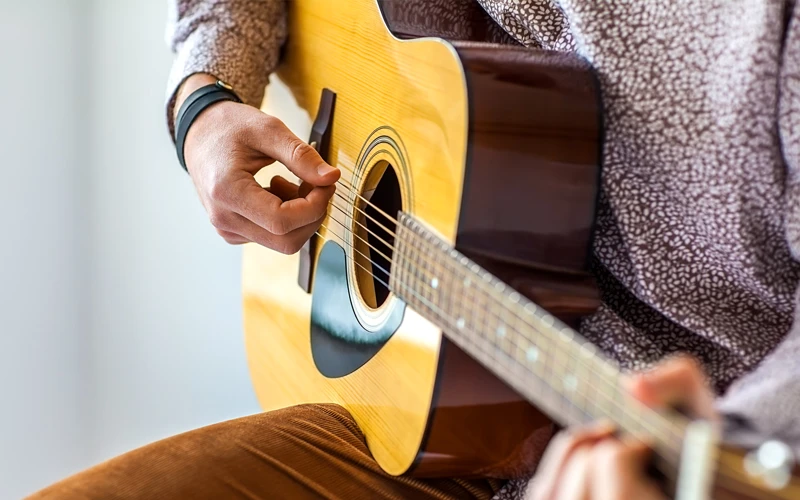Country music is known for its rich storytelling and soulful melodies, often accompanied by the gentle strumming of an acoustic guitar. In country bands, the acoustic guitar plays a pivotal role in creating the signature sound that defines the genre. Acoustic guitar techniques in country music are diverse, ranging from traditional fingerpicking to percussive strumming patterns. In this article, we will explore some of the essential acoustic guitar techniques used by country bands to enhance their music and captivate audiences.
Traditional Fingerpicking
One of the most iconic acoustic guitar techniques in country music is traditional fingerpicking. This technique involves plucking the strings with the fingertips or fingernails of the right hand to create intricate and melodious patterns. Fingerpicking allows guitarists to play both the melody and accompanying chords simultaneously, giving the music a full and rich texture.
Country bands often use fingerpicking to add depth and emotion to their songs, particularly in ballads and slower tunes. Artists like Chet Atkins and Merle Travis are renowned for their mastery of fingerpicking, influencing generations of country guitarists.
To master traditional fingerpicking, aspiring country guitarists should focus on developing independence in their right-hand fingers and practicing scales and arpeggios to improve dexterity and coordination. By honing their fingerpicking skills, guitarists can elevate their playing and bring a timeless quality to their music.
Chicken Pickin’
Another distinctive acoustic guitar technique commonly found in country bands is “chicken pickin’.” This technique involves a combination of picking and muting to create a sharp and percussive sound reminiscent of a chicken clucking. Chicken pickin’ is often used in upbeat and lively country songs to add a playful and dynamic element to the music.
Guitarists achieve the chicken pickin’ sound by picking the strings with a combination of the pick and the fingers of the right hand while muting the strings with the palm of the hand to create a staccato effect. This technique requires precision and control to execute effectively, but when done right, it can give country music a unique and energetic flair.
Country guitarists looking to incorporate chicken pickin’ into their playing should practice alternating between picking and muting while maintaining a steady rhythm. Listening to artists like James Burton and Albert Lee, who are known for their masterful chicken pickin’ technique, can also provide inspiration and insight into this lively and engaging style.
Hybrid Picking
Hybrid picking is a versatile acoustic guitar technique that combines fingerpicking with the use of a pick to create a rich and nuanced sound. In country music, hybrid picking is often used to play fast and intricate passages with precision and clarity. By holding the pick between the thumb and index finger of the right hand and using the remaining fingers to pluck the strings, guitarists can achieve a seamless blend of picking and fingerstyle techniques.
Country bands employ hybrid picking to add complexity and depth to their music, allowing them to explore a wide range of tones and textures. This technique is particularly effective in country rock and bluegrass styles, where fast-paced solos and intricate melodies are common.
To develop proficiency in hybrid picking, guitarists should practice exercises that focus on coordination between the pick and fingers, as well as scales and arpeggios that require a combination of picking and plucking. By mastering hybrid picking, country guitarists can expand their musical repertoire and enhance their playing with a dynamic and expressive technique.
Flatpicking
Flatpicking is a fundamental acoustic guitar technique that involves using a flat pick to strike the strings with precision and power. In country music, flatpicking is often associated with fast-paced and energetic playing, making it an essential skill for country guitarists looking to add excitement and intensity to their music.
Country bands incorporate flatpicking into their repertoire to create driving rhythms and blistering solos that showcase the technical prowess of the guitarist. Artists like Doc Watson and Tony Rice are revered for their mastery of flatpicking, inspiring a new generation of country guitarists to push the boundaries of the technique.
To excel at flatpicking, guitarists should focus on developing speed, accuracy, and control in their picking hand. Practicing scales, exercises, and songs that emphasize flatpicking will help guitarists build the dexterity and stamina needed to play with power and precision. By harnessing the energy and drive of flatpicking, country guitarists can elevate their playing and captivate audiences with their dynamic performances.
Travis Picking
Travis picking is a fingerstyle guitar technique named after country music legend Merle Travis, who popularized the style in the 1940s. Travis picking involves alternating the bass notes with the melody and chords, creating a syncopated and driving rhythm that propels the music forward. This technique is commonly used in country and folk music to add a sense of momentum and groove to the songs.
Country bands often incorporate Travis picking into their music to create a lively and engaging sound that keeps audiences tapping their feet. By mastering the alternating bass pattern and syncopated rhythm of Travis picking, guitarists can infuse their playing with energy and vitality, making their music irresistible to listeners.
To practice Travis picking, guitarists should start with simple patterns and gradually increase the complexity as they become more comfortable with the technique. Listening to recordings of Merle Travis and other Travis picking pioneers can also provide valuable insight into the nuances and subtleties of this dynamic fingerstyle technique. With dedication and practice, country guitarists can harness the power of Travis picking to take their playing to new heights and connect with audiences on a deeper level.
Looking to explore the world of acoustic guitars in country music? Learn about different acoustic guitar body styles, essential techniques used by classic country bands, top acoustic guitarists in country music, the history of acoustic guitars in the genre, and how to properly tune your guitar for that authentic country sound!
Conclusion
Acoustic guitar techniques play a crucial role in shaping the sound and style of country bands, allowing guitarists to express themselves creatively and connect with listeners on a profound level. From traditional fingerpicking to chicken pickin’, hybrid picking, flatpicking, and Travis picking, country guitarists have a wide array of techniques at their disposal to enhance their music and elevate their performances.
By mastering these acoustic guitar techniques and incorporating them into their playing, country bands can create captivating and memorable music that resonates with audiences and stands the test of time. Whether evoking the melancholy strains of a ballad or the exuberant energy of an upbeat tune, acoustic guitar techniques are the heart and soul of country music, enriching the genre with their beauty and complexity.



